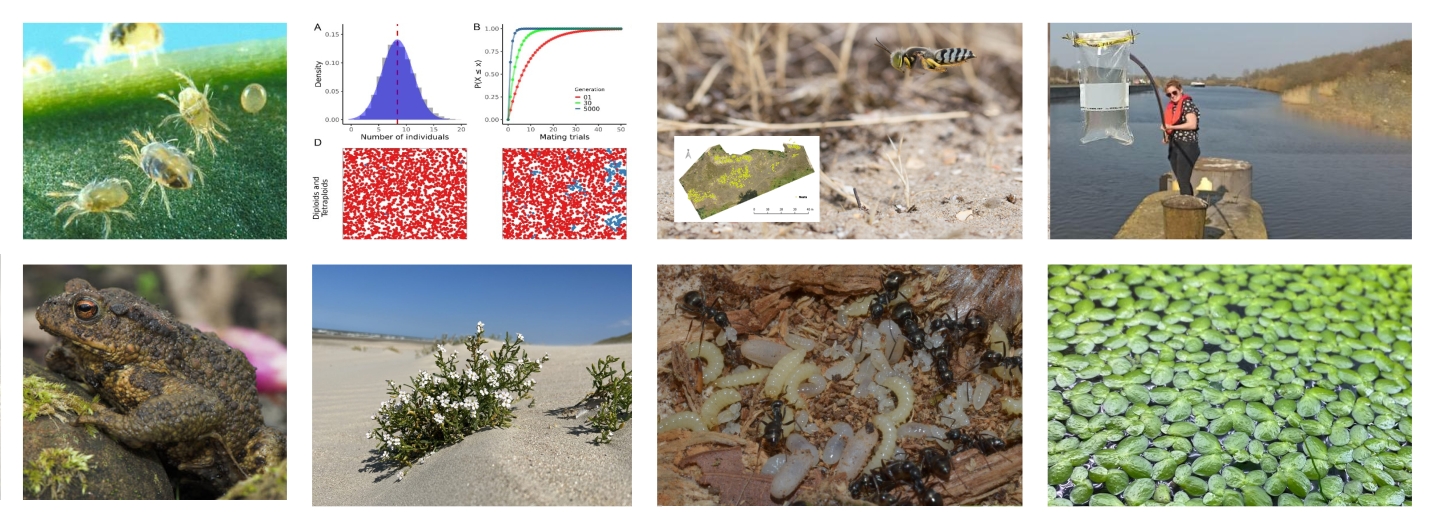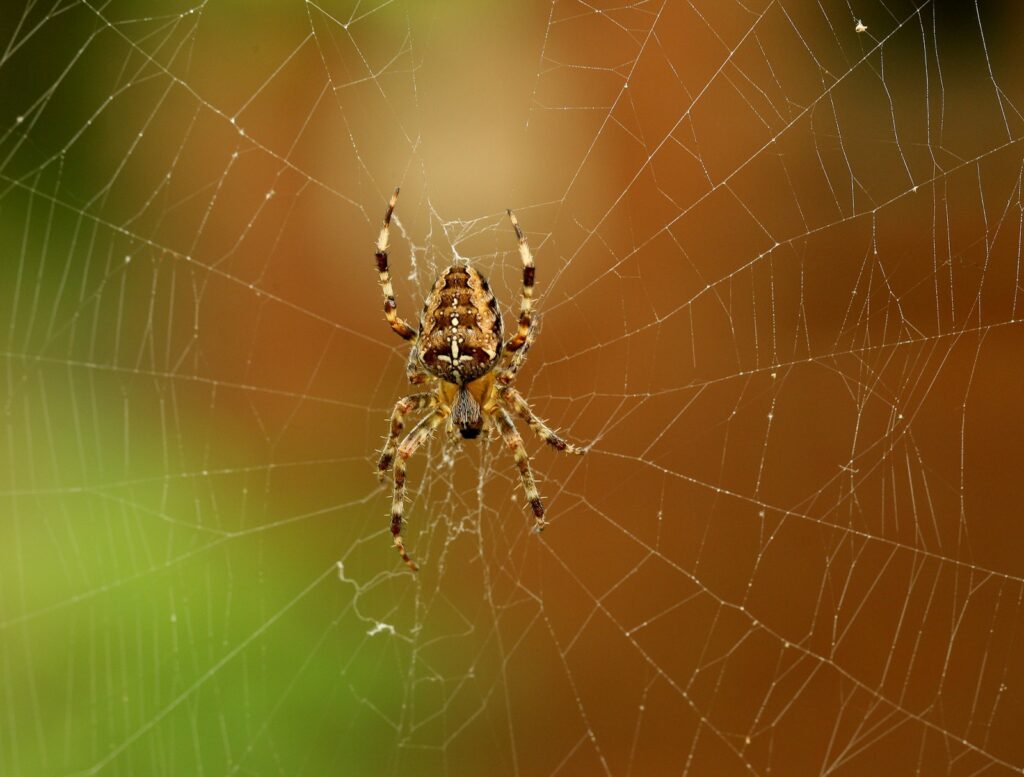
Research overview
We strive to unravel the eco-evolutionary mechanisms behind population dynamics, community assembly but also their important applications. We consider spatial interactions as a central process behind the structuring of biodiversity at different scales.
We are particularly interested in understanding how these interactions determine feedbacks among/between ecological and evolutionary processes. We aim to understand how ecological and evolutionary interactions impact the spatial organisation of biodiversity at local, regional and global scales. We are not focused on specific taxonomic groups, but we have a particular interest in the evolution of dispersal, the distribution and community ecology of arthropods, plants (that doubled their genome) and their associated microbiomes. An important angle of our research is on understanding the potential, relevance, and limits of eco-evolutionary dynamics in nature.
We achieve these goals by integrating theoretical, observational and experimental approaches, using a wide array of methodological techniques (from molecular techniques to remote sensing) by collaborating with partners from multiple national and international research institutes and universities. While radical socio-economic changes are needed to preserve biodiversity and human well-being, we see ecology and evolution as key-processes in ecosystem functioning and thereby hope to contribute to the implementation of sustainable development goals, by supporting nature-based solutions and biodiversity conservation.

Dispersal ecology & evolution
Understanding the mechanisms leading to variation in dispersal is of crucial importance to understand how changes in habitat- and resource distribution feedback on higher-level ecological processes and patterns. We use behavioural ecological and field-based approaches with arthropods and plants as model systems to study the ecological and evolutionary drivers of movement and dispersal, and mesocosms approaches to infer its impact on patterns of ecological specialisation and range expansion.
We generate solid theory on the eco-evolutionary aspects of dispersal by means of individual based modelling. Current projects focus on the importance of costs and trade-offs on spread dynamics of dune-building grasses, temperature dependency of dispersal in food webs and the diversity dependency of dispersal (see this Phil. Transactions B special issue).
Researchers involved: Femke Batsleer, Maxime Dahirel, Frederik Mortier,Garben Logghe, Heleen Van Ransbeeck

Eco-Evolutionary dynamics in space
With the introduction of the concept of metapopulations the awareness that spatial structure affects demographic and population dynamical processes steadily grew. Such a variation in spatial structure generates typical disequilibrium conditions which are mediated by population extinction and variable demographic dynamics. In contrast to single, unconnected populations, local selection pressures are expected to operate in concert with those acting at the metapopulation level. Given the fact that the vast majority of theory on life history evolution neglects extinction-recolonisation dynamics typical for metapopulations and the complex connection among traits, we combine experimental evolution of spider mites, plants (whote clover, duckweed) with modeling to understand complex eco-evolutionary dynamics. We specifically focus on mite-clover coevolution in experimental metapopulations, urban evolution and the integration of ecology into our understanding of polyploid establishments and diversity (Methusalem project lead by Prof. Van de Peer) in spatially structured systems. We combine such research with field-based studies focussing on dispersal and life history evolution dynamics in function of urbanisation, habitat fragmentation and range expansion. We tightly collaborate with the Wybouw-lab @TEREC.
Researchers involved: Karen Bisschop, Frederik Mortier, Silvija Milosavljević, Felipe Kauai Pereira, Siebe Van Wunnik, Lennert Beele

Community ecology & evolution
The way local communities and ecosystems react to environmental change depends on interaction between local and regional responses at all scales of biological organisation. The spatial configuration of populations and communities is as such an important environmental driver as it determines rates of movement and the strength of local and regional regulatory processes. The importance of inter- and intraspecific variation in arthropods traits for ecosystem functioning is studied in coastal dunes and urban environments. We rely on citizen science to collect global data on orb web spider traits (SpiderSpotter App) and develop theoretical models to understand the importance of body size and movement (evolution), foodweb and metacommunity functioning. Recent projects focus on the organisation of communities associated with single arthropod species: arthropod nest symbionts in ants and microbial associations in spider mites. The local (mal)adaptation of woodland strawberry to current and future climate and local herbivory is studied in the Biodiversa project PlantCline.
Researchers involved: Femke Batsleer, Karen Bisschop, Frederik Van Daele, Katrien De Wolf, Charlotte Taelman, Charlotte Van Driessche, Garben Logghe

Nature-based solutions, ecological restoration and biological conservation
Anthropogenic disturbance and nature management have severe effects on the ecological and evolutionary mechanisms that eventually local diversity and ecosystem functioning. We use these insights to study the impact of urbanisation and climate change on plant-plant, plant-herbivore and plant-arthropod interactions using survey and experimental approaches. We further perform applied ecological research that aim to understand and predict the specific impact of connectivity restoration and nature management on the conservation and restoration of arthropod, plant, but also amphibians and freshwater fish diversity. Much conservation-oriented research is performed in close collaboration with INBO.
We have a specific expertise in coastal dune ecology and develop predictive models to assess the impact of climate change on coastal dune functioning and the development of dunes as nature based solutions. We coordinate in this respect an EU-horizon project on mainstreaming biodiversity in dune-dike hybrid NbS (DuneFront), and are partners in a VLAIO Blue Cluster project SUSANA to investigate whether alternative sediments can be used as a fundament for such dune-based NbS.
Researchers involved: Femke Batsleer, Maxime Dahirel, Frederik Van Daele, Orane Mordacq, Ellen Blomme, Maaike Dhondt, Charlotte Taelman, Charlotte Van Driessche, Henri Rommel, Heleen Van Ransbeeck
